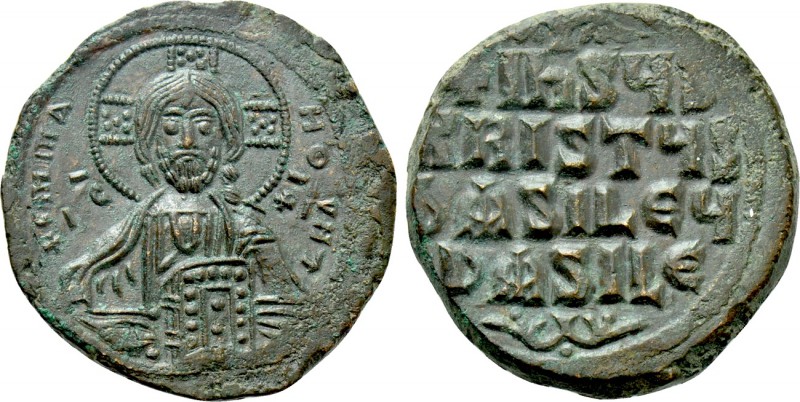 Byzantine "anonymous folles" of the 10th-11th centuries
Byzantine "anonymous folles" of the 10th-11th centuries Byzantine "anonymous folles" of the 10th-11th centuries
Byzantine "anonymous folles" of the 10th-11th centuries
For ten centuries Roman and Byzantine emperors regularly put their heads and names on their coins. Then, in AD 970 the pious emperor John I Tzimisces make a remarkable change in the copper coins (folles). He issued folles with a facing bust of Christ and the emperor's name omitted (therefore, "anonymous"). It was the first copper type to portray Christ. This change initiated a 120-year-long series of "anonymous folles," sometimes called "anonymous bronze." (They are really copper, but traditionally they are called bronze anyway.)
At the upper right is an example. It is 27 mm anonymous follis of "Class A2" attributed to the reign of Basil II (the Bulgar Slayer) and Constantine VIII, 976-1028. Sear 1813.
Obverse: A facing bust of Christ with a large halo (nimbus) and
+EMMA-NOVHA (Emmanuel) around. He holds the Gospels.
Small IC XC either side (for "Jesus Christus". "X" is a chi in Greek, the first letter of "Christ" in Greek.)
Reverse: A four-line legend:
+IhSUS (Jesus)
XRISTUS (Christ)
bASILЄU (King of
bASILЄ (kings)
Class A2 has a variety of decorations in the nimbus and above and below the reverse legend. This example has five dots in each quadrant of the nimbus, two dots on the gospels, and an elaborate design above and below the reverse legend. (It is type 40 in the Dumbarton Oaks list of decorations which is given here.)
What's new? 2022, Sept. 27: An example of the very rare "Class L."
2022, Sept. 19: A variety of Class A2 with different spelling.
2021, April 16: An example of Class A1 overstruck on a coin of the previous emperor, Nicephorus II.
Table of Contents:
Introduction (at the top and continued below) [A different page is "An Introduction to Byzantine Coins" in general.]
All types illustrated in a table with identification and distinguishing features (with links to larger images and discussions of the types).
A table of frequencies of the types.
How attributions were determined by scholars.
Examples of overstrikes.
Reference works.
A page of examples of Class A discussed in greater detail.
A page of examples of Classes B through K and some imitations.
Note for Collectors: There are twelve major types (a.k.a. classes). Some are very common and always available. Almost all pieces are quite worn and lack details on the face so it will be a challenge to get excellent examples. The best discussion of these types is in Grierson's Byzantine Coins which is also the best book for understanding Byzantine coinage. If you want to collect Byzantine coins, you need Sear. If you want to understand them, you want Grierson and Whitting (reference works are below). If you want lots of academic commentary and pictures which are good for identifying coins, get the massive 9-book series of Dumbarton Oaks catalogs [DOC].
Next is an unusually nice example of "Class G" with Christ and the Virgin Mary.
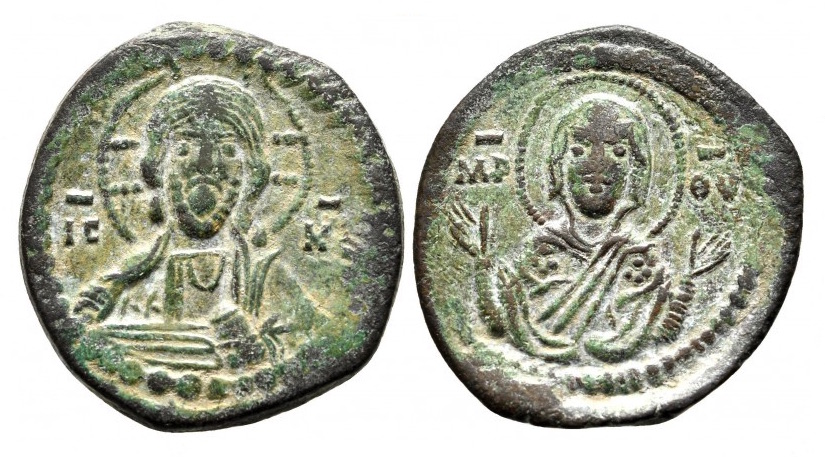
Anonymous bronze.
28-26 mm. 7.30 grams.
Class G. Sear 1867.
Attributed to emperor Romanus IV, 1068-1071
(who lost the critical Battle of Manzikert to the Seljuq Turks).
Obverse: Facing bust of Christ, holding a scroll in his left hand and rasing his right hand in benediction.
IC to left, XC to right.
Reverse: The Virgin Mary orans (that is, holding out both hands as shown)
MP to left, ΘV to right (Mother of God)
Introduction, Continued. All during this period there was only one copper denomination, the follis. Through the reign of Nicephorus II (963-969) folles have the name of the ruler. Then there are no folles in the names of John I Zimisces [also spelled Tzimisces] (969-975) through Isaac I (1057-1059). After Isaac I the emperors who issued anonymous folles also issued named folles (Table far below).
Value. Traditionally there were 288 folles per gold piece, and that may be true for these too, although the very large early Class A2 pieces might have a different tariff [Morrison, page 585].
The Types. The twelve types are listed in the next table. They are anonymous, so it is not obvious which emperor issued which type. The methods used to attribute them are discussed below. The first challenge was to put them in chronological order. Finally, when all were in order, the types were assigned letters A, B, C, etc. in order. Class A was divided into two (A1 and A2) to indicate two distinguishable issues with the same design (one author even proposed a Class A3). Because the first type was known to belong to John I from ancient sources, the attribution of Class A1 is certain. Overstrikes allow the attributions of some other classes to be deduced. However, the attributions of Classes B, C, and D are still disputed. Grierson writes, "The attribution of the Anonymous classes to individual rulers is best avoided." (BC, page 205) Nevertheless, almost everyone does it anyway. The attributions of both Sear and Grierson are given in the table.
| Class | Sear | Ruler, dates |
Image, linked to more about the class (click the image) |
distinguished by |
| A1 | 1793 | John I, 969-976 Grierson in DOC has this continuing until perhaps 989. |
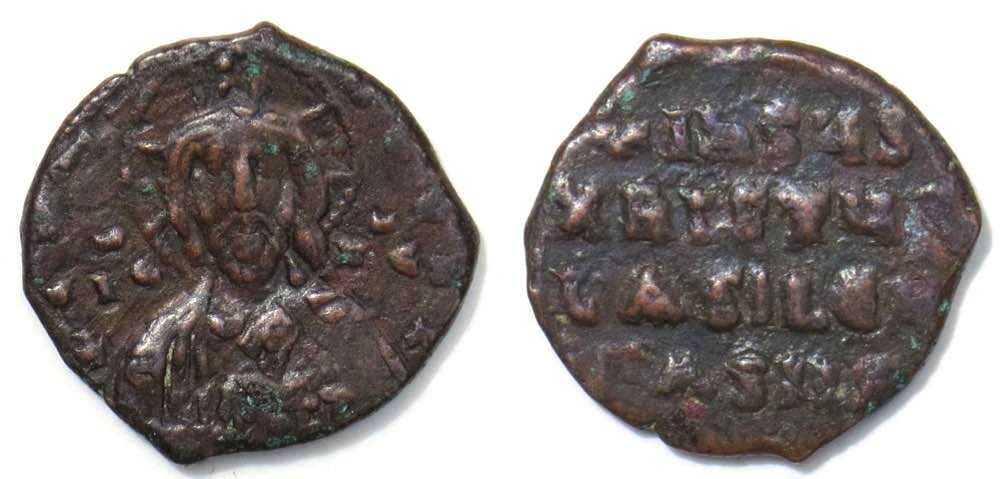 |
4-line legend as A2, but lighter and often smaller. |
| A2 | 1813 |
Sear: Basil II & Constantine VIII, 976-1028* Grierson in DOC: Likely |
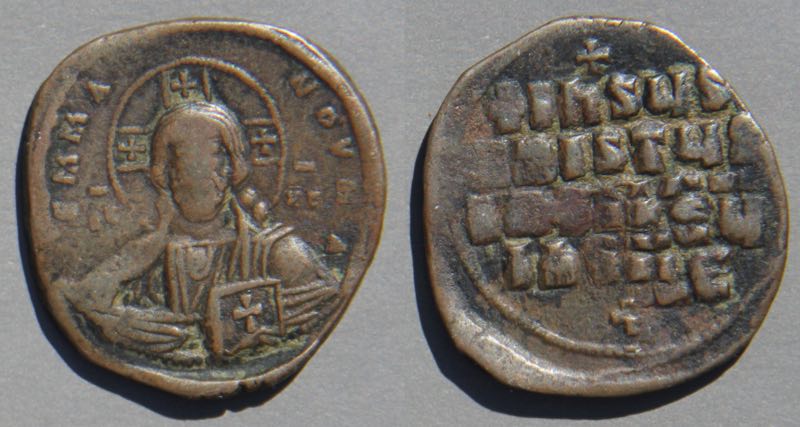 |
4-line legend: |
| B | 1823 |
Grierson in DOC: Michael IV, |
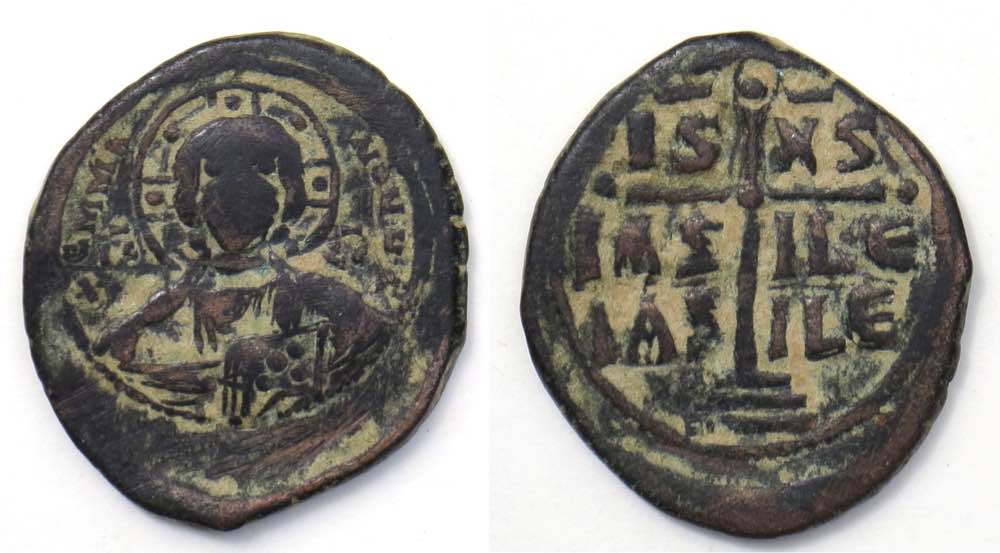 |
Cross on three steps, with |
| C | 1825 |
Grierson in DOC: Constantine IX, 1042-1055 |
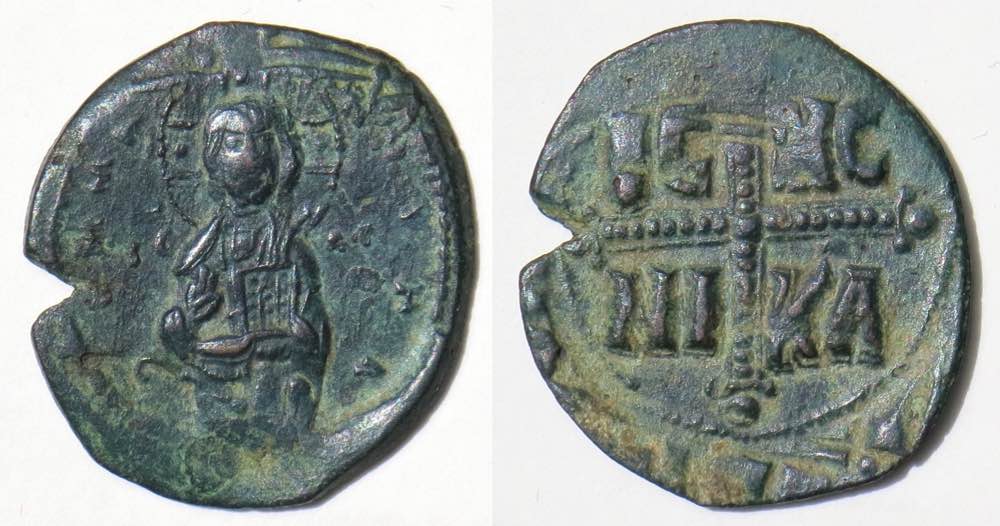 |
Almost full-length figure of Christ |
| D | 1836 |
Sear: Grierson in DOC: |
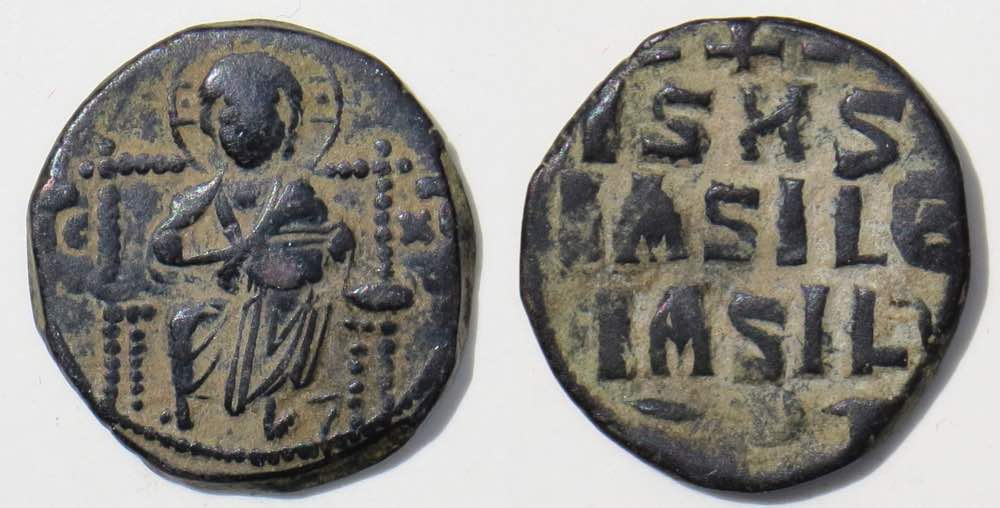 |
Christ seated facing on throne |
| E | 1855 |
Both Sear and Grierson agree on the remaining types: Constantine X, 1059-1067 |
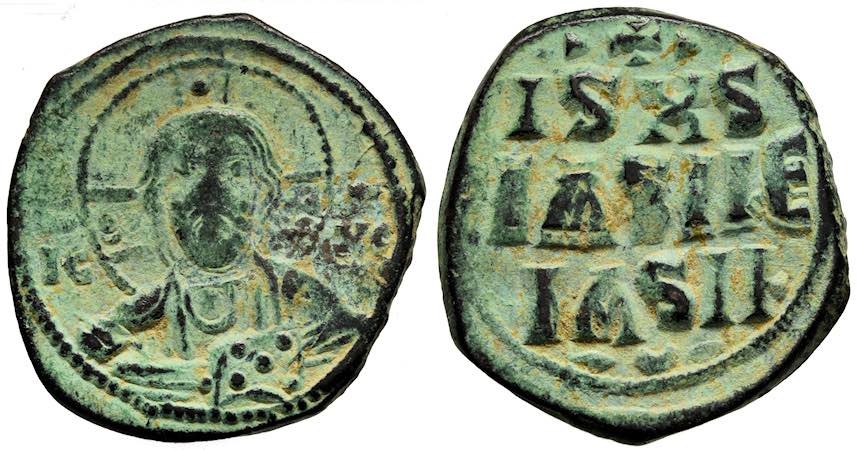 |
Bust of Christ facing |
| F | 1856 | Constantine X, 1059-1067 | 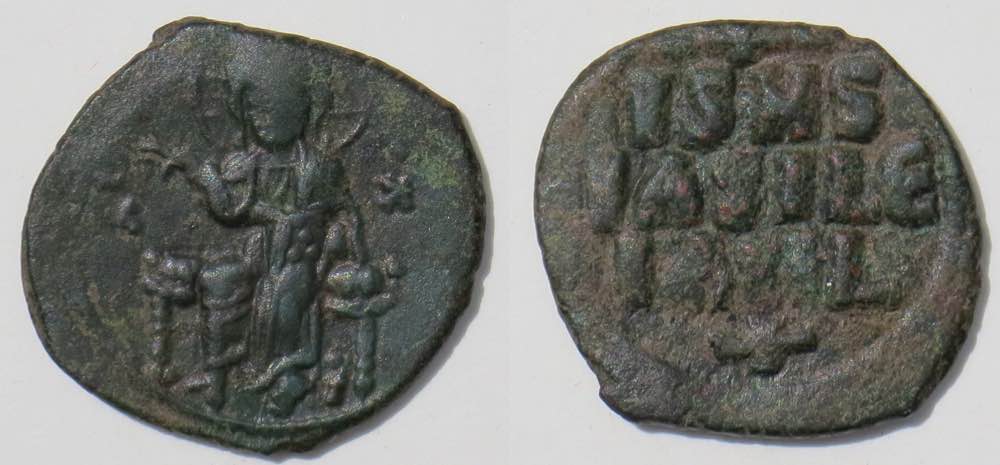 |
Christ seated (unlike Class D, this seat has no back), raising right hand in benediction |
| G | 1867 | Romanus IV, 1068-1071 |  |
Virgin Mary orans |
| H | 1880 | Michael VII, 1071-1078 |  |
Patriarchal cross |
| I | 1889 | Nicephorus III, 1078-1081 | 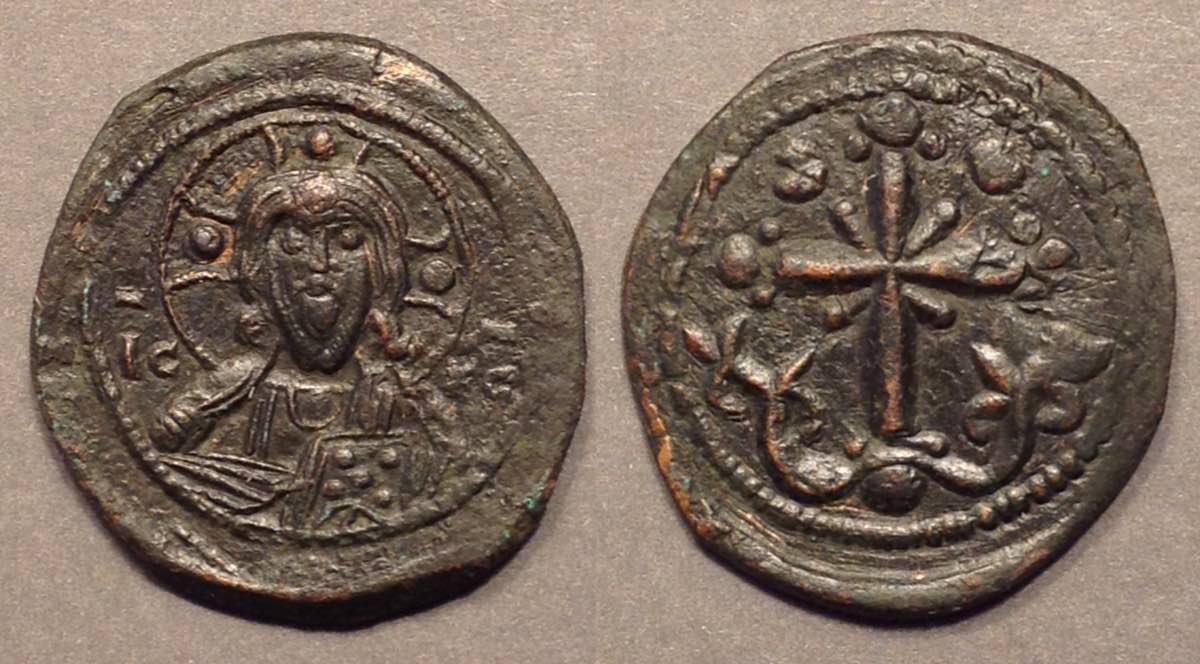 |
Latin cross, X at center, balls and pellets at the ends, |
| J | 1900 | Alexius I, 1081-1118 | 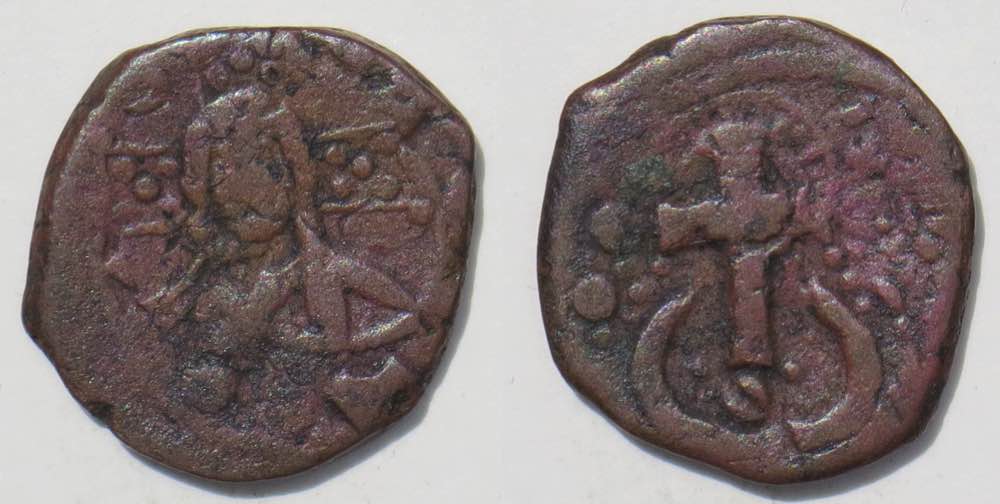 |
Christ has no nimbus (no circle). |
| K | 1901 | Alexius I, 1081-1118 | 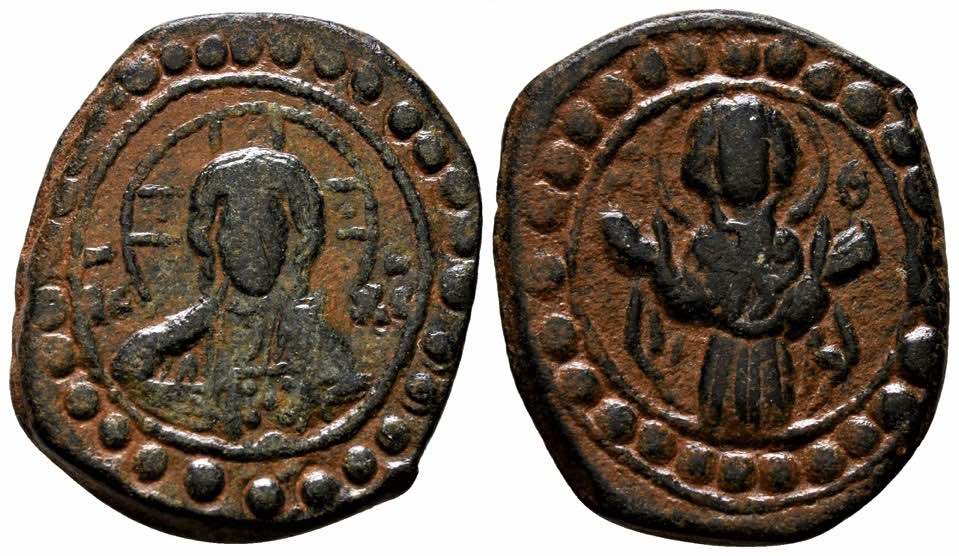 |
Virgin Mary, orans, within circle of large pellets as part of the design inside the rim |
Comments for Collectors:
Because Sear's book is most accessible, most sellers and collectors use Sear's attributions.
* Basil II died in 1025 and the terminal date of Class A2 is not known. Metcalf (1970, 1979) proposed a Class A3 with no change in design but a reduction in weight to about 2/3 the previous weight, that is, a weight of about 8 to 11 grams. He also proposed some were minted at "central Greek" local mints. He made the distinction between Class A2 and Class A3 using weights, style, and find locations. In his classification, certain ornament varieties in the table are given to Class A3 and some to central Greek mints. He asserted that older publications misclassify many Class A3 coins as Class A1 because coins with light weights that did not fit into Class A2 were put into Class A1, but with his scheme could be put into Class A3 using the ornaments above and below the reverse legend to make the distinction. For details, see Coinage in South-Eastern Europe, 820-1396. Although Sear mentions Class A3, most sources, including this page, have chosen to lump all sizes of Class A coins after Class A1 into Class A2 and omit Class A3. His Ph.D. student Vasso studied the matter and decided there were not central Greek mints and there is no distinctive Class A3. This web page agrees with Vasso and does not distinguish Class A3.
The attributions of Classes E through K are inferred from overstrikes on named types, but the rulers associated with Classes A2 through D are not so certain and are discussed below.
Grierson notes that coins from the former Classes L (below) and M have since been attributed as a local coinage of Trebizond and that we now know from better examples that Class N is not actually anonymous, rather in the name of some usurper Nicephorus. (BC, page 205) Unfortunately there are at least two usurpers named Nicephorus and it is unclear which Nicephorus it is.
For relative frequencies of the types, see the table below.
A1 is scarce. Also, a large percentage of coins offered for sale as A1 are actually misattributed A2 coins.
A2 is very common. It comes in various sizes from 35 mm down to 25 mm. It comes in over 60 varieties of ornamental decorations (see a table here). Class A2 began with a reform of the small Class A1 pieces, retaining the design but making them much larger. Over time they became smaller (but not as small as many A1 pieces) and then they were replaced by Class B pieces.
All the types are hard to find with a good strike and full facial features on the obverse. When offered, they sell for a large multiple of (maybe ten times) the price of a piece that is otherwise nice but barely has dots for eyes (which is as good as is usually offered).
The remainder of this page has details about frequencies and methods of attribution. Feel free to skip it and
Go directly to more examples and information about Class A or Classes B-K.
Another type: Here is a type discovered after the usual A through K classification was adopted.
| The "Amorium type." The sequence and date are uncertain. It has similarities with Class I |
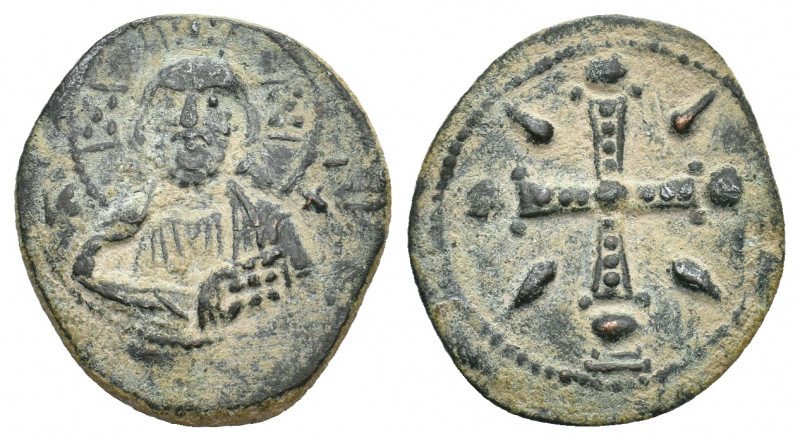 |
26 mm. 4.77 grams. Bust of Christ facing, five dots in each part of the numbus. Square cross, beaded, with wedges in the quadrants. This type is known from at least a dozen examples. The type was published in Numismatic Circular [Spink] (Dec. 1995, page 376) by C. S. Lightfoot who reported an example found in the excavations at Amorium in central Turkey. It was previously thought to be of Richard, regent for the Count of Edessa, but is found overstruck on other Byzantine anonymous folles (of Class C, D, E, or I) and is likely to be Byzantine as opposed to Crusader. Not in Sear, it might be given the new number 1903B. This example from Bucephalus auction 6, lot 781, image used with permission. |
Classes L, M, and N. When the A through K classification system was inititated in 1954 there were three more extremely rare types called Classes L, M, and N, known only from a few illegible examples. Since then a few more have been found with enough recorded findspots and legible letters to attribute them. Class N is now assigned to the usurper Nicephorus Basilacius (Bland, NC 1992). Classes L (next) and M (Bendall, NC 1977, issue 5) are anonymous and have been attribtuted to the mint of Trebizond.
Frequencies. Here is a table intended to give a feeling for the relative frequencies of the types. The table gives the number and fraction of each type in seven major published collections. If you don't want to study all of it, just look at the three colums near the right with "%". The column (Md%) to the left of the vertical dark bar gives the median percent in the seven collections listed. For example, reading that column, we see a typical major collection might have Class D pieces as about 6.2% of its anonymous folles.
The rightmost four columns summarize data from Museums and Excavations in Turkey as summarized in "Byzantine Anonymous Folles in the Bolo Museum" by Serkan Kiliç. The column M% gives the percents from 15 Turkish museums in his Table 4. The rightmost column (E%) gives the percents from the 12 excavation reports summarized in his Table 5.
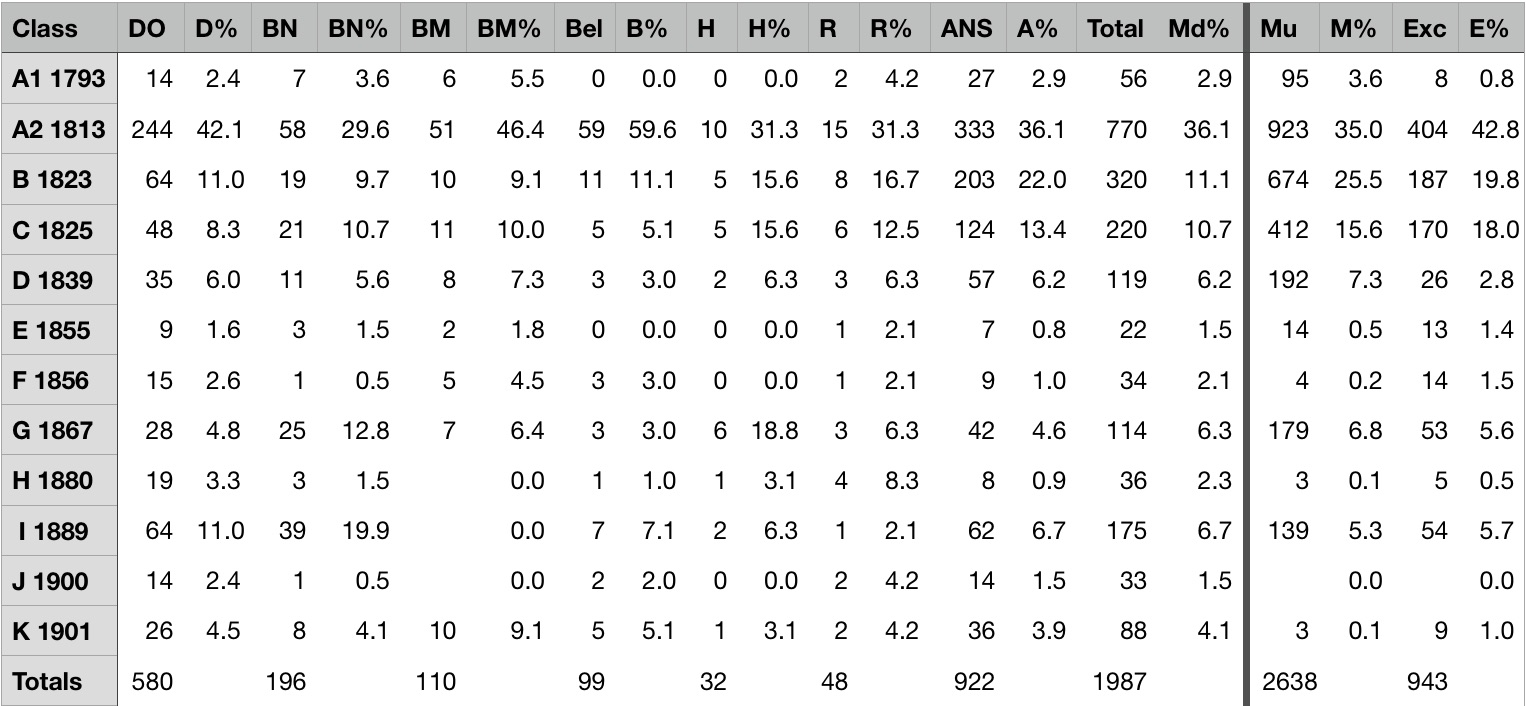
Key to columns:
Class gives the class and its Sear number.
DO gives the number of pieces in the Dumbarton Oaks catalog. D% gives the percent of the total number of anonymous pieces (580 in the bottom row) in that collection that are of that class. So, it says 2.4% of their anonymous folles are Class A1.
Total (second to the left of the vertical dark bar) sums the number of that class in the seven collections consulted. 1975 anonymous-follis coins are in the collections.
Md% gives the median percent in the seven collections (six collections for the three classes, H, I and J, not listed by BMC).
Mu (to the right of the vertical bar) gives the total numbers of coins from 15 Turkish museums in Kiliç's Table 4. "M%" turns that into percents. Kiliç did not include Class J because there were none in the Bolu museum (personal communication). This is unfortunate because his tables exclude information about the number of Class J coins at the other museums and excavations. They must have must have had some, but his tables do not let us know.
Exc gives the total numbers from the 12 excavation reports summarized in his Table 5. Some of the excavation report data was probably wrong. For example, the excavation report at Antoch ad Orontes reported 166 Class A2 coins and no Class A1 coins, which seems unlikely.
BN = Biblioteque National catalog, published 1970. (See the bibliography below for details of the references.)
BM = British Museum Collection, published 1908. The classes had not yet been defined and BMC assigns the types in different order, but inspection of the entries and regrouping by class yielded this. At the time BMC was written, Classes H, I, and J were considered to be crusader coins and not regular Byzantine coins, so they were not in the catalog and their cells are empty. The "median %" column takes the median of the five collections that do list them.
Bel = Belgrade = Byzantine Coins in the National Museum of Belgrade, 2006
H = Byzantine and Early Medieval Western European Coins in the Hunter Coin Cabinet, 1998.
R = Ratto, the 1930 sale catalog "Monnaies Byzantine et d'autre pays contemporaines" reprinted by Schulman in 1959. It has two extremely nice Class A1 folles (lots 1920 and 1921) that are 27 and 26 mm--significantly larger than most. Class H, I and J coins in the Ratto collection were in the Crusader's category (which is based on the same categorization for those classes proposed by Wroth in the BMC collection) on page 137 and plate LXIII (coin numbers 2493 to 2499).
ANS refers to searches done on-line August 2018 at their web site under "Byzantine, coin" and Class-letter.
http://numismatics.org/search/results?q=department_facet%3A%22Byzantine%22%20AND%20objectType_facet%3A%22Coin%22&lang=en
Comments: Class A2 is the most common class, although the numbers are probably inflated by the fact it comes with over 60 varieties of decorations. If a museum's collection is to be complete, they must continue to collect these long after they have enough of each of the other classes.
** BN does not make it easy to distinguish which are A1 and which are A2 among the 65 Class A folles listed. Most are listed with a variety from the Table of A2 varieties, but 17 are not. Seven of those 17 are small enough to probably be A1, but some others might be as well. I have, without conviction, put seven down as the number that are Class A1.
** BMC was written long before these alphabetically-named classes were proposed. The coins are not described using Classes A1 and A2. They are on pages 476ff. Wroth attributes Class A2 varieties by looking for similar ornaments on named gold. That seems a good idea, but it led to numerous attributions that are no longer accepted. Among the 57 folles we would call Class A, I found six overstruck pieces (John I, numbers 31-36, pages 478-479, one of which is pictured and certainly Class A1), which we would list as Class A1. All the rest are listed with the ornaments of Class A2.
"D, E, and F are notably rare" Grierson (BC, page 205). E and F are rare perhaps because the output of copper of Constantine X who minted them was shared with his named types (see the next table).
Classes, Attributions, and Overstrikes. Because they lack any emperor's name it was, and in part remains, a challenge to attribute them. Over the decades scholars have proposed various schemes. Most useful for attribution is that many of the coins are overstruck on other anonymous types and named types. It is possible to put them in chronological order because the undertype must be earlier.
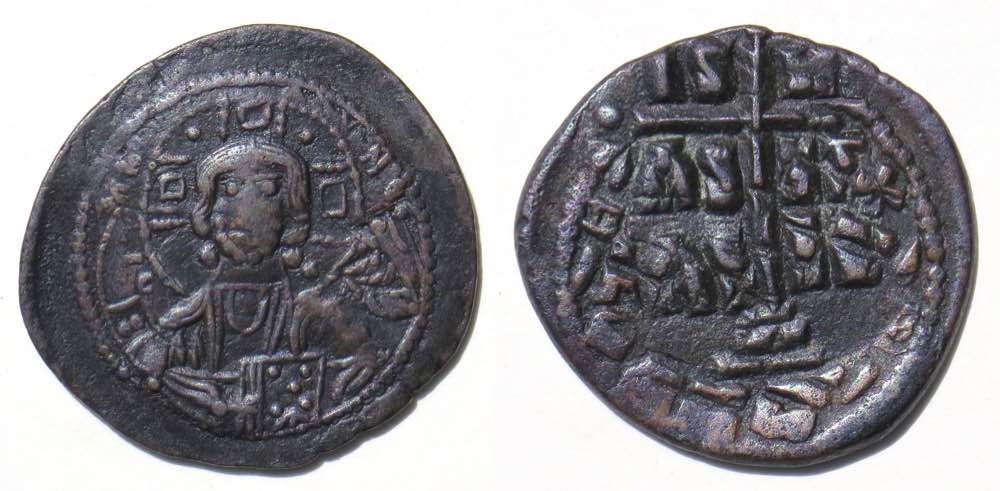
Class B over Class A2. Sear 1823 over Sear 1813.
36-34 mm. 14.00 grams.
The image is oriented so the Class B reverse is up. The cross is high on the flan with IS XS above and bASILЄ/bASILЄ below the crossbar.
The undertype, Class A2, has its top at 4:00 and the "+" of the first line of the four-line legend is clear at 2:00 and its end is clear at 5:30. The next image rotates the reverse so the Class A2 undertype is up.
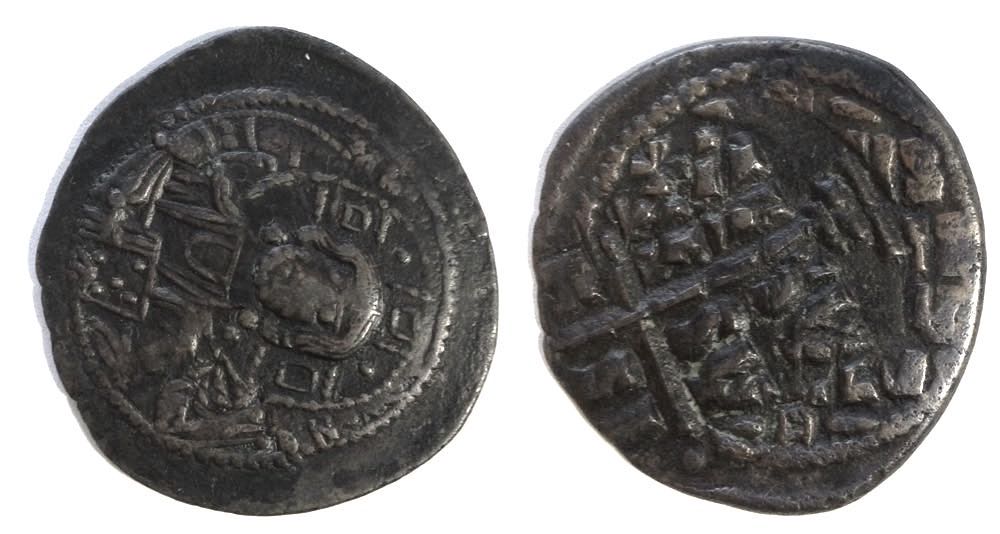
At 10:00 the + begins the top line of the undertype
+IhSUS and the US is visible at 1:30. Each of the ends of the four lines is visible from 2:00 to 4:30, and the bottom ornament is at 6:00 and the top at 12:00..
The obverse overstrike has almost obliterated the undertype. The right shoulder of Christ remains at 7:00-6:00 and a bit of the nimbus and a lot of its circle is just inside the beading from 11:00 - 1:00.
Class B is usually close to 30 mm., whereas Class A2, which lasted a long time, can be from 35 to 25 mm. This Class B was overstruck on a very large (probably early) Class A2 of 36-34 mm.
So, Class A2 is before Class B.
(For other examples of overstrikes, see below.)
Finally, when enough overstruck coins with identifiable under- and over-types were found, it was possible to construct a sequence and each type was assigned a "class" in alphabetical order corresponding to chronological order: Class A is before Class B is before Class C, etc.
Class A comes in two distinct sizes now called A1 (smaller) and A2 (larger). So Classes A1 through K (twelve types) had to be attributed (not counting three extremely rare classes, L, M, and N, discussed below the table). The alphabetical sequence has remained undisputed since Margaret Thompson's work in 1954. However, the sequence alone does not assign them to emperors.
 I do not know why there are so many overtruck coins. They are anonymous, so the emperor does not have the incentive of getting his name or face on coins. I am unaware of demonetization of previous issues (which would mean they needed a new, overstruck, type to retain their status as money). If you know of any scholarly treatment of this, please contact me:
I do not know why there are so many overtruck coins. They are anonymous, so the emperor does not have the incentive of getting his name or face on coins. I am unaware of demonetization of previous issues (which would mean they needed a new, overstruck, type to retain their status as money). If you know of any scholarly treatment of this, please contact me: 
Some of the later overstrikes involved named types, which give useful information about the possibilities. For example, Class J folles [image to the right] are sometimes overstruck on named coins of Nicephorus III, so they must be issued by an emperor at least as late as Nicephorus III. We think the attributions of Classes E through K are assured by considering named overstrikes. But the attributions of Classes A2 through D are not as certain.
 Prior to the anonymous series emperors put their names on copper coins. There are no named copper folles of emperors John I (969-976) through Constantine IX (1042-1055). Folles of Class A1 are similar in size and often overstruck [image to the right] on named folles on Nicephorus II (963-969) who was the last emperor before emperors without named folles. [The reverse shows "+ҺICH..." which the the top line of a coin of Nicephorus--Sear 1783--and on the obverse at 6:00 "+ҺIC" is visible.] Also, the Byzantine historians Scylitzes and Cedrenus explicitly attribute the first anonymous types with Christ to John I Tzimisces (969-976). So the attribution of Class A1 to John I is certain.
Prior to the anonymous series emperors put their names on copper coins. There are no named copper folles of emperors John I (969-976) through Constantine IX (1042-1055). Folles of Class A1 are similar in size and often overstruck [image to the right] on named folles on Nicephorus II (963-969) who was the last emperor before emperors without named folles. [The reverse shows "+ҺICH..." which the the top line of a coin of Nicephorus--Sear 1783--and on the obverse at 6:00 "+ҺIC" is visible.] Also, the Byzantine historians Scylitzes and Cedrenus explicitly attribute the first anonymous types with Christ to John I Tzimisces (969-976). So the attribution of Class A1 to John I is certain.
Whitting also illustrates an example of Class A1 over a named follis of Nicephorus II (963-969) [Photos 298-299]. DOC 3.2 has six examples, three illustrated, of Class A1 over Nicephorius II.
After that is is not so simple. In the interval from 969 to 1059 with no named folles we recognize ten reigns and only five anonymous types, so it is obvious the types do not necessarily coincide with reigns. Grierson states, "There is no reason to suppose changes of type corresponded with changes in ruler." (BC, page 205) Modern attributions are stated as if they do, but we do not know that types were introduced when rulers changed, although that seems a good possibility. In that interval without named folles there are five substantial reigns and five others with short reigns. So the problem is to assign the various types to the emperors, respecting the over- and undertypes.
In 1954 Thompson proposed the attributions used by Sear, except for Class E [image to the right], which Thomson gave to Isaac I, but the discovery of an overstrike of Class E on a coin of Constantine X necessitated a reattribution of Class E to the later emperor. (A table of named types for possible overstrikes is below.) Grierson notes, "The transfer of Class E to Constantine X raises problems regarding the earlier chronology for which no fully satisfactory solution can be offered." [DO, page 639]
[image to the right], which Thomson gave to Isaac I, but the discovery of an overstrike of Class E on a coin of Constantine X necessitated a reattribution of Class E to the later emperor. (A table of named types for possible overstrikes is below.) Grierson notes, "The transfer of Class E to Constantine X raises problems regarding the earlier chronology for which no fully satisfactory solution can be offered." [DO, page 639]
Sear is such an important and available reference that most sellers use Sear's attributions today. This is not the same as saying they are necessarily right. The problem is there are too many substantial reigns from John I through Constantine IX for the number of anonymous classes and we have no good reason to think any class A-D, ended at the end of a reign. Remember, they are anonymous so a new emperor would not have his name on the coins anyway. Thompson and Sear assign the first five anonymous types to rulers with substantial reigns in the gap and none are assigned to the rulers with very short reigns.
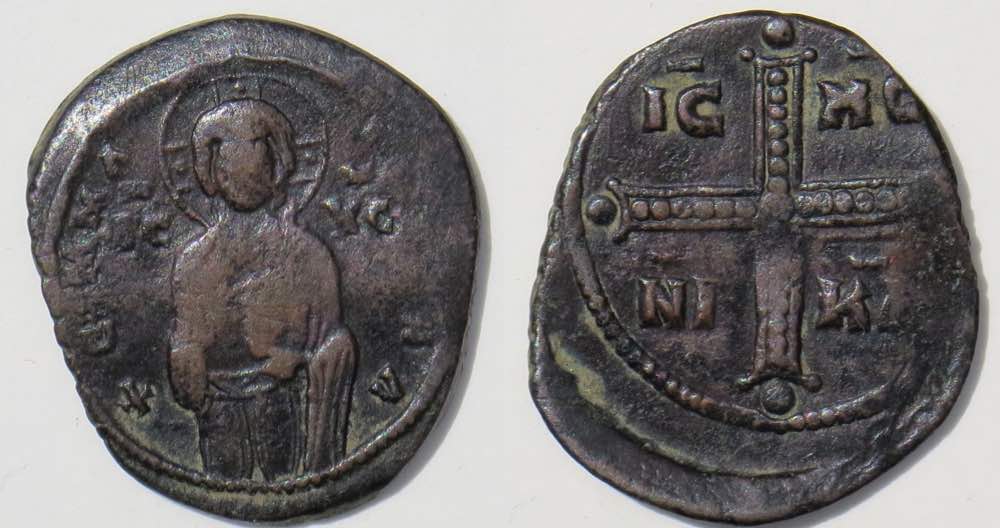 Grierson, author of the relevant Dumbarton Oaks catalog in 1973 and the excellent survey book in 1982, proposed different attributions for Classes A2-D. They are mentioned by Sear at each entry, but are not Sear's primary attributions. Grierson has Classes A1 and A2 continuing longer and proposes a key chronological fixed point with the change of obverse for Class C [image to the right], which he is certain is the effigy of Christ Antiphonetes, an icon held in particular veneration by empress Zoe [DOC, page 636]. Zoe had an amazing and complicated life. She was the daughter of Constantine VIII, wife of Romanus III, then wife of Michael IV, then ruled alone briefly, then was deposed, and then was reinstated to rule with her sister Theodora, and then married to Constantine IX. The change to Class C associated with Zoe happened in there somewhere. Grierson suggests 1042 [DOC, page 639] near the end of the reign of the compliant Michael V (four months in 1041-1042), making most Class C coins belong to Constantine IX, 1042-1055, and not the earlier Michael IV, 1034-1041, given by Sear.
Grierson, author of the relevant Dumbarton Oaks catalog in 1973 and the excellent survey book in 1982, proposed different attributions for Classes A2-D. They are mentioned by Sear at each entry, but are not Sear's primary attributions. Grierson has Classes A1 and A2 continuing longer and proposes a key chronological fixed point with the change of obverse for Class C [image to the right], which he is certain is the effigy of Christ Antiphonetes, an icon held in particular veneration by empress Zoe [DOC, page 636]. Zoe had an amazing and complicated life. She was the daughter of Constantine VIII, wife of Romanus III, then wife of Michael IV, then ruled alone briefly, then was deposed, and then was reinstated to rule with her sister Theodora, and then married to Constantine IX. The change to Class C associated with Zoe happened in there somewhere. Grierson suggests 1042 [DOC, page 639] near the end of the reign of the compliant Michael V (four months in 1041-1042), making most Class C coins belong to Constantine IX, 1042-1055, and not the earlier Michael IV, 1034-1041, given by Sear.
Mints. All types are usually attributed to the mint of Constantinople, although Metcalf and Hendy have found coins that might be from subsidiary mints. See Grierson (DOC, pages 640-641) for a discussion of the many proposals about possible mints. When Grierson wrote there was not enough evidence to be certain there was any mint other than Constantinople.
* Basil II died in 1025 and Constantine VIII ruled alone 1025-1028. D. M. Metcalf thought the Class A types from that interval might be distinguishable and called them Class A3, however this idea has not been widely adopted.
Overstrikes. Overstrikes play a major role in determining the sequence of types and their attributions. Here are a few examples.

Class C over Class B. Sear 1825 over Sear 1823.
30-27 mm.
The image is oriented so the Class C reverse is up.
The undertype is not very clear on this example, but its top is visble at 6:30 with traces of the crossbar and legend above the crossbar around 6:00 and two of the three steps of the cross clear between IC and XC.
So, Class C is later than Class B.
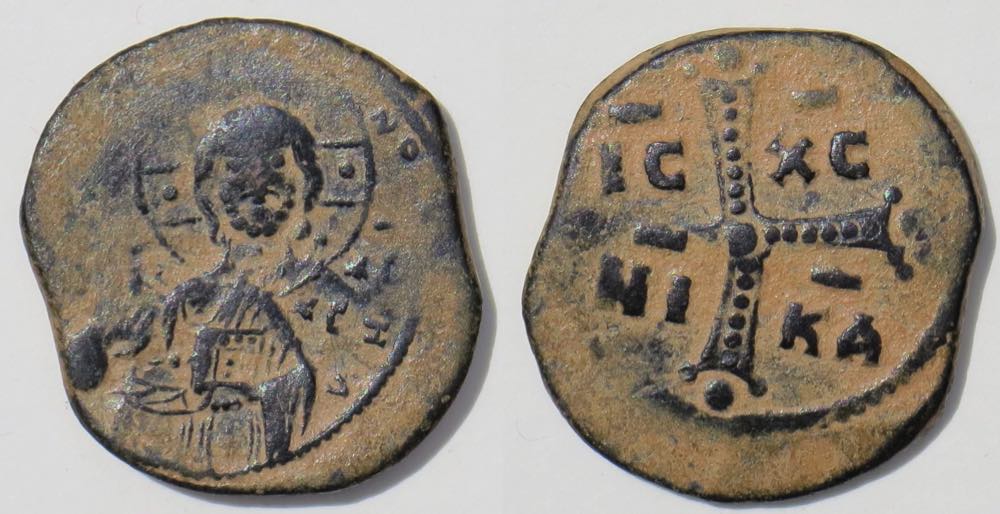
Class C over Class B.
27-26 mm.
The obverse is oriented so the bust of Christ from Class B (the undertype) is up and clear on the top half of the flan. The bottom of the 3/4-length figure of Christ of Class C is very clear with the bottom half of the flan.
The reverse shows a very clear Class C reverse, double struck.
So, Class C is later than Class B.
It is unusual to have one side of the undertype so clear.

Class D over Class C.
33 mm (larger than usual)
The obverse is oriented so Class D is up. The jeweled cross of a Class C reverse can be seen under it from 8:30 to 2:00.
Because the reverse of C is under the obverse of D, the obverse of C ought to be under the reverse of D, but it is lost in the garbled strike.
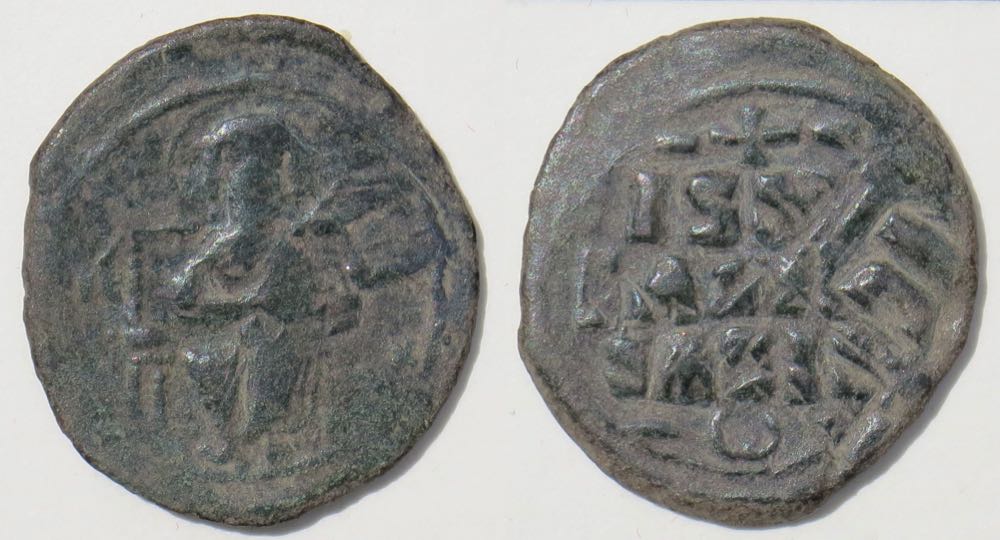
Class D over Class C.
32-29 mm.
The images are oriented so Class D is up.
The bottom of the obverse image of Class C (almost full-length figure of Christ) is visible at 2:00 on the obverse. The upper and left part of the reverse cross and IC is visible at 4:00 on the reverse.
So, Class D is later than Class C.
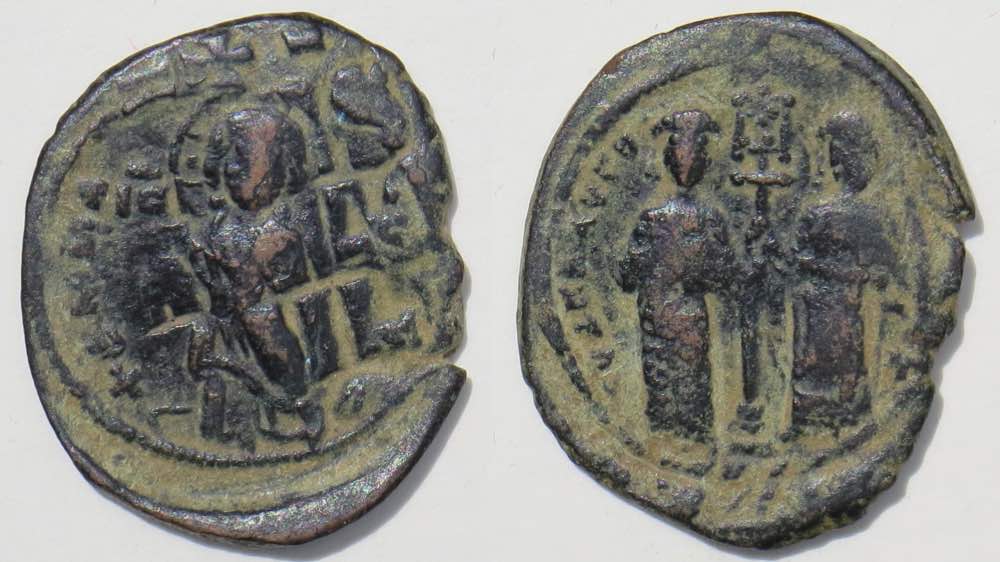
A named Constantine X type overstruck on a Class D anonymous follis.
On the reverse, the two standing figures either side of the labarum are the reverse type of a named type of Constantine X (Sear 1836). The three-line reverse legend of the undertype, Class D, is visible on the obverse, with the + above (at 11:30 at the rim), and the lines tilted up from 8:30 to 2:30.
31-26 mm. 8.80 grams.
Sear 1853 over Sear 1836.
So, Class D was struck at latest during the time of Constantine X.
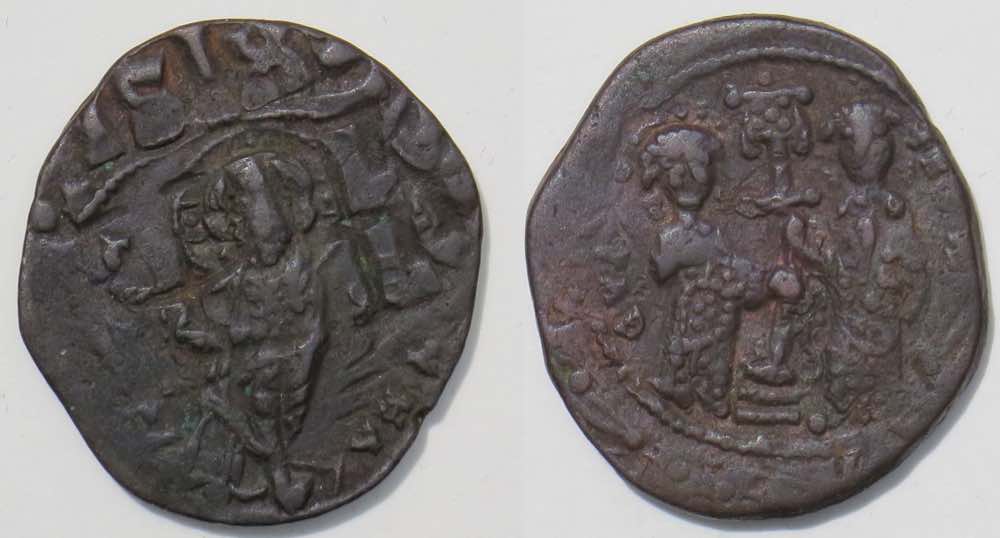
Constantine X overstruck on Class B.
Sear 1853 over Sear 1823.
29-26 mm. 9.07 grams.
Again, the reverse is a clear named Constantine X.
For the undertype Class B, the top of the reverse cross and IS XS is at 11:30 on the obverse and right side of the rest of Class B is visible, as are even the steps of the cross (just in from 5:00).
Many coins of Constantine X are overstruck on anonymous folles. This example does not tell us as much as the previous overstrike because Class B is earlier than Class D.
This site does not illustrate examples that establish the sequence of the other classes.
Continue with the page on Class A anonymous folles
or continue with the page on folles of Classes B-K.
Major:
Sear, David. Byzantine Coins and Their Values, 1987, pages 375-383. [This book has a very nearly complete list of Byzantine coin types in all metals. It has numerous photographs, but very many types are not photographed. It has short biographies on each emperor, and occasional one-line comments about types. It is not a book to read, rather a book to consult. Some common types can be identified by comparsion with Sear's photographs, but very many types are merely well-described. If you want illustrations of the high percentage of the Byzantine coins you will encounter, Grierson's Byzantine Coins and Dumbarton Oaks volumes have them.]
Grierson, Philip. Catalogue of the Byzantine Coins in the Dumbarton Oaks and Whittemore Collection, Volume 3, Part 2, 1973, pages 634-706. [This volume has the most detailed list of anonymous bronze types, with substantial discussion and illustrations of all types, sometimes two or more of a given type. The entire series of 9 books is commonly called "Dumbarton Oaks (DO or DOC)."]
Grierson, Philip. Byzantine Coins. 1982. [Pages 204-210 and plates 56-57]
[The best book for understanding Byzantine coinage. It has 385 pages of text and 1527 coins illustrated in black-and-white on 95 page plates. It covers the entire Byzantine series. It is not a book for beginning collectors, rather the latest scholarly word (as of 1982, but not yet superceded) on Byzantine coins. Grierson is organized chronologically and attempts to be systematic and thorough. See Whitting below for another recommended book.]
Note: Hahn's 3-volume MIB series on Byzantine coins does not cover coins as late as the anonymous series.
Kiliç, Serkan. "Byzantine Anonymous Folles in the Bolo Museum," Cedrus IV (2016) 315-339
avaiable at https://www.academia.edu/12657555/Byzantine_Anonymous_Folles_in_the_Bolu_Museum
Penna, Vasso. "Byzantine Monetary Affairs During the 8th, 9th, 10th and 11th Centuries," a PhD thesis of over 400 pages from Oxford University by Vassiliki Athanassopoulou-Pennas, available here at Oxford University's research archive: https://ora.ox.ac.uk/objects/uuid:02e4cf82-a638-4bd2-a45b-09c17c585dc8
Other, in order of usefulness, the ones most useful for the study of anonymous folles first:
Morrison, Cecile. Catalogue de Monnaies Byantine, Bibliotheque Nationale. 1970. Two volumes. In French. [Pages 584-605 in volume II. Morrison, 1970 (before DOC by Grierson in 1973). It has 103 page plates of Byzantine coins. The numbering system is very awkward. It has a discussion, in French, of the history of the attributions of anonymous folles (pages 584-586) but merely states what each previous scholar decided without taking sides.]
Radic, Vesna and Vujadin Ivanisevic. Byzantine Coins in the National Museum of Belgrade, 2006. Large 8 1/4" x 11" PB. 1106 coins well-illustrated in B&W on 66 page plates with identifications in Bulgarian on facing pages. 32 of the introductory pages are in English.
Bateson, J. D and I. G. Campbell. Byzantine and Early Medieval Western European Coins in the Hunter Coin Cabinet, 1998. HC, 6 1/4" x 10". 179 pages of identifications with almost all coins pictured on 29 page plates. No commentary.
Wroth, Warwick. Imperial Byzantine Coins in the British Museum. 1908. Reprinted by Argonaut in 1966. [This book is largely outdated. It does have pictures and it correctly identifies the easy-to-identify named coins of earlier emperors, but it is mostly wrong about anonymous folles.]
Metcalf, D. M. "Interpretation of the Byzantine Rex Regnantium folles of Class A" in Numismatic Chronicle 1970, pages 199-219.
Metcalf, D. M. Coinage in South-Eastern Europe, 820-1396. HC. RNS. 1979. Pages 55-62 discuss Class A folles and which varieties are his Class A3.
Whitting, P. D. Byzantine Coins. 1973. In the "World of Numismatics" series.
An excellent book on Byzantine coins, written with the collector in mind. This would be my top or second-favorite book for general knowledge about Byzantine coins, but, for purposes of this web page, it does not have much information on anonymous folles. It has very many enlarged B&W photos and many enlarged color photos. It is more lively and entertaining than Grierson and the enlarged photos are more fun to look at, but the text is less systematic and thorough. I love this book and would recommend it right after Sear as a book for collectors.
Hendy, M. F. Coinage and Money in the Byzantine Empire, 1081-1261. 453 pages and 51 plates in the format of the DOC series. [This is a very important work, but has little to do with anonymous folles except for the possibility that mints other than Constantinople are identifed in the time period of the book and those mints may have existed earlier and issued anonymous folles.]
Bendall, Simon. "The mint of Trebizond under Alexius I and the Gabrades" in NC, 1977, 126-136 and plates 6-7, which reattributes Class L as Type 8 from Trebizond.
Bland, Roger. "A follis of Nicephorus Basilacius?" NC, 1992, 175-177 and plate 36B.
Thompson, Margaret. The Athenian Agora, II. Coins from the Roman through the Venetian Period. 1954. Pages 73-74 and 109-115.
A website on the varieties of Class A: https://www.forumancientcoins.com/numiswiki/view.asp?key=Anonymous%20Byzantine%20Class%20A%20Folles
A thread on vrieties of Class B: https://www.numisforums.com/topic/6686-the-variations-of-class-b-anonymous-follis/
Return to the top of this page.
Go to the page on Class A anonymous folles.
Go to the page on folles of Classes B-K.
Go to the Table of Contents of this whole educational site.
Site first posted August 19, 2018.